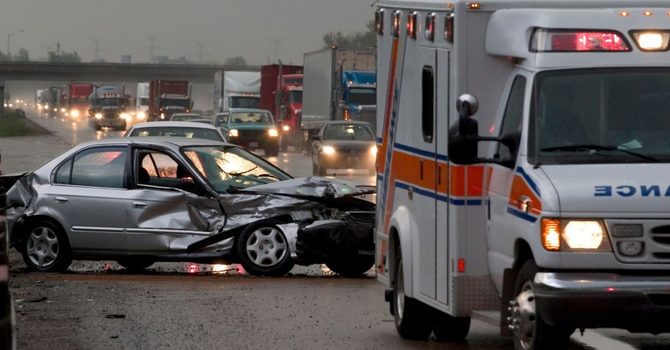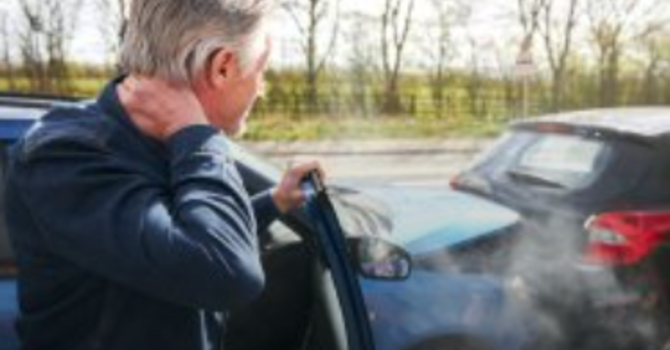
You’ve just been in a car accident. You walk away with a little soreness and maybe a few bruises or scratches.
You feel alright until you don’t. What you thought was soreness in your legs doesn’t go away. In fact, it gets worse.
The pain might vary, but the most noticeable quality about it is — it’s happening in your legs, but your legs aren’t injured. If this sounds like you, you might have sciatica.
Read more to decode sciatica’s origin and causes and to find a resolution for your pain.
Table of Contents
- What Is Sciatica?
- What Happens During a Car Accident That Can Cause Sciatica?
- Why Is It So Important To Diagnose and Treat Sciatic Pain After a Car Accident?
- What Does Treatment for Sciatica Pain After a Car Accident Typically Look Like?
- Cascade Spine & Injury Center Can Help Heal Your Sciatica After a Car Accident

What Is Sciatica?
Sciatica is generally referred to as pain down the leg as a result of back injury or compression to the lumbar region or the sciatic nerve.
There are two types of sciatica which include:
- Lumbar radiculopathy: This condition is directly caused by the compression of the sciatic nerve or nerve root.
- Deep referred pain: This form of sciatica is not caused by nerves but instead by other issues in the lumbar, muscles, and joints.
Overall, lumbar radiculopathy is referred to as true sciatica, but healthcare providers often use the term sciatica as a layman’s term for lumbar issues that cause pain in the legs. The conditions are the same and the definition only matters when determining treatment.
General causes of sciatica include:
- Pelvic injury or fracture
- Slipped or herniated disc
- Spinal stenosis
- Piriformis syndrome
- Tumors
Sciatica is a symptom of a medical problem, not a condition. Pain is generally the first symptom of sciatica. The pain typically indicates irritation or inflammation. The pain from sciatica may be felt as a searing, tingling, or burning pain that is usually felt in only one leg.
The pain can also be described as:
- A persistent, dull ache
- Shooting, electric pain
- Tingling or pins and needles (paresthesia)
- Muscle weakness or numbness
Sciatica pain is typically worsened by the flexion of the lumbar spine, coughing, bending, twisting, or sitting for long periods.
How is sciatica diagnosed?
Sciatica is generally diagnosed after a healthcare provider reviews a patient’s medical history and performs a physical examination. The physical examination may largely depend on the leg raising test, also referred to as Lasegue’s sign.
What Happens During a Car Accident That Can Cause Sciatica?
Car crash injuries are often a result of crash force. Crash force is calculated by the weight of the body multiplied by the speed of the vehicle.
There are three types of collisions, or impacts, involved in every crash which include:
- First impact: The vehicle collides with another object (which takes some of the energy from the crash).
- Second impact: The occupant’s body collides with the inside of the car (which is where most of the energy absorption happens).
- Third impact: This type of impact involves the internal organs hitting other organs and bones.
The secondary impact is where most lumbar issues are developed. This is usually due to the body straining against the seatbelt or other areas of the car, like the dashboard or foot pedal. This strain may result in the compression or herniation of the discs or facet joints in the lumbar. Hip injuries caused by secondary impact may also inflame and compress the sciatic nerve. Tissue injury due to bracing may also cause sciatica.
How soon would I have sciatica after a car accident?
Sciatica resulting from a car accident injury can develop immediately or days after. In some instances, sciatica can appear weeks or even months after the accident. How soon you develop sciatica may depend on the severity and location of the injury.
3 Types of Forces That Can Cause Sciatic Pain After a Car Accident
#1: Compressive Force
Compressive force is when a force presses inward on an object causing it to become compressed.
The two most reported mechanisms of back injury due to compressive force happen when the knees meet the dashboard and when the seat belt activates to restrain the passenger. This can result in the compression of the lumbar and hips, which may result in pinched nerves, tissue damage, fracture, and/or dislocation.
#2: Shearing Force
Shearing force is when unaligned forces move one part of the body one way and another in a different way. This results in tissues, joints, or bones moving in opposite directions, which can result in injury.
This kind of force can happen in a car accident where the occupant is pulled in multiple directions while being restrained by the interior of the car and/or seat belt.
The shear force limit of the lumbar is suggested to be anywhere from 500-1000 Newtons, which roughly translates to 112-224 lbs. of force, depending on size and age. By using the previous calculation, if an occupant weighs 150 lbs. and is in a collision at 30 mph, the total force would be 7,500 Newtons. This would be enough force to potentially cause lumbar injury that may lead to sciatica.

Why Is It So Important To Diagnose and Treat Sciatic Pain After a Car Accident?
Diagnosis and treatment are necessary for pain relief. Sciatica can be debilitating and may take up to 4-6 weeks to go away on its own — if you’re lucky. For some, sciatic nerve pain may persist for months to years if not treated.
Remember, the source of sciatica is not where the pain originates. To treat leg pain caused by sciatica, the origin injury must be located and managed.
In cases where a collision causes lumbar radiculopathy, the compression of the sciatic nerve may result in further complications if not resolved. This could lead to:
- Worsening pain
- Incontinence
- Nerve damage
- Foot drop
- Loss of muscular strength in the affected leg
How Do You Know If You Have Nerve Damage After a Car Accident?
Nerve damage can generally be defined by its symptoms and diagnosed by a healthcare provider. There may be no definitive way to diagnose nerve damage, so it is important to see a healthcare provider to accurately diagnose your suspected nerve damage.
If you are in a car accident and suspect that you are injured, do not wait to seek medical services.
Cascade Spine & Injury Center is a multidisciplinary, holistic clinic that specializes in chiropractic, massage, acupuncture, and exercise therapy.
Our clinic was founded by Dr. Jonathon McClaren, who is a chiropractic physician in the state of Oregon. Dr. McClaren is also an accredited accident reconstructionist with a certification in Spinal Biomechanical Engineering and post-doctoral training in multiple fields relating to traumatic injuries.
Can Whiplash Cause Sciatic Nerve Pain?
Whiplash can sometimes have an indirect influence on sciatica pain after car accidents. Whiplash typically does not directly result in sciatica pain, but it might secondarily trigger it.
While whiplash tends to affect your cervical vertebrae (the vertebrae in your neck), sciatica pain may develop from whiplash due to the interconnectedness of the vertebrae, like the lumbar vertebrae.
Whiplash injuries can cause the atlas and axis vertebrae to become misaligned. When the axis becomes dislodged, it may cause the axis to twist and impact the lower vertebrae. Your posture might also be affected by whiplash injuries, which can put strain on your lower back, resulting in inflammation and compression of nerves.

What Does Treatment for Sciatica Pain After a Car Accident Typically Look Like?
General treatment for sciatica pain may vary due to the condition causing the sciatica. For sciatica pain after car accidents, your healthcare provider may prescribe non-invasive treatments. These rehabilitative treatments may be performed in congruence with other treatments.
Cascade Spine & Injury Center offers custom treatment plans that reflect your injury and healing goals. We want you to feel understood and heard as we partake in your remedial journey. Schedule an appointment to begin today.
Chiropractic Care
For sciatica pain after car accidents, chiropractic adjustments may be applied to the pelvis and lower thoracic spine. The lumbar is to be avoided since it is the source of injury. Instead, a chiropractor will work to adjust the areas above and below the origin injury to reduce stress and inflammation.
Chiropractic treatment can help facilitate healing naturally by reducing biomechanical stress. This allows the body to enable healing from within.
Exercise Therapy
After an injury, muscles and tendons can become weak. After all, a prolonged symptom of sciatica may sometimes be muscle weakness. Exercise therapy is a great way to help restore strength and coordination. It may also help prevent reinjury and reduce inflammation.
Studies have shown that exercise therapy is a great way to reduce the symptoms of sciatica and lower back pain. This is supported by scientific evidence that suggests that therapeutic exercise helps release endorphins. Endorphins are nature’s painkillers and may help decentralize some of your sciatica symptoms.
Massage Therapy
Massage therapy can help with sciatica pain after a car accident by manipulating the tendons, ligaments, and tissues in the lumbar. The movements and pressure help blood travel through congested areas to increase blood flow.
Researchers suggest that massage therapy can help increase the range of motion, decrease pain, and promote healing in patients with sciatica pain.
In addition to treating sciatica pain after a car accident, massage therapy can help:
- Increase relaxation
- Promote circulation
- Enhance wellness; and
- Improve immune function
Acupuncture
Acupuncture is a mostly painless procedure that uses the ancient practice of needle insertion to facilitate the flow of chi. This may result in accelerated healing, decreased pain, and improvement of other body systems.
Acupuncture is a great treatment for sciatica because the main goal is pain reduction and increased healing. One study suggests that acupuncture may be more effective at relieving sciatica pain after car accidents than NSAID treatment.
Cascade Spine & Injury Center Can Help Heal Your Sciatica After a Car Accident
Don’t let your sciatica pain after a car accident linger. Car accident injuries are often cumulative rather than immediate. Your sciatica may go away on its own, but why suffer until it does?
Cascade Spine & Injury Center is Portland’s premier car accident chiropractor. Our lead physician and founder, Dr. McClaren, is a licensed chiropractic physician who specializes in accident reconstruction and spinal biomechanical engineering.
At Cascade Spine & Injury Center, we do not stop at treating injuries caused by car accidents. Other conditions we provide treatment for include:
- Whiplash
- Work injuries
- Concussion
- Neck pain
- Back pain
- Shoulder pain
- Headaches; and
- Sports injuries
Schedule an appointment and begin your recovery today.
The content in this blog should not be used in place of direct medical advice/treatment and is solely for informational purposes.





